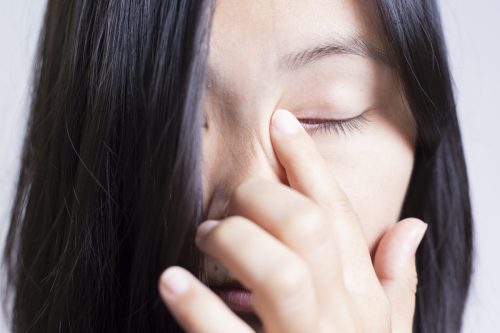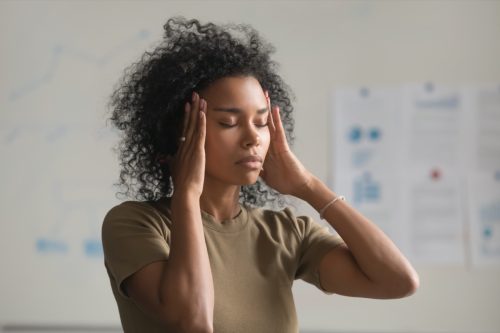4 Reasons to Get Botox That Have Nothing to Do With How You Look
Wrinkles are only one thing this drug treats, doctors say.

Most of us have heard of Botox, but you might not know that the popular drug was originally approved by the U.S. Food & Drug Administration (FDA) in 1989 to treat crossed eyes (strabismus) and blepharospasm (uncontrollable blinking). It wasn't until 2002 that the FDA okayed it for more superficial treatments like smoothing out wrinkles between the eyebrows. Today, while we still may associate the drug with cosmetic purposes, it also has become a go-to treatment for a variety of other issues that have nothing to do with looking younger.
"Botox is not just a beauty treatment! It actually can be used to alleviate many medical conditions," board-certified family physician Laura Purdy, MD, tells Best Life. "Of course, we do use it to help with muscles of the face, because the muscles of facial expression are the same muscles that can result in wrinkles and other signs of aging. But when used in other areas of the body, Botox can be a very effective and safe treatment."
Akis Ntonos, FNP, co-founder of Aion Aesthetics, says patients also get Botox for a number of reasons that are not currently FDA-approved, a practice known as "off-label use." He says these include erectile dysfunction (ED), premature ejaculation, temporomandibular joint (TMJ) disorders, and bruxism (teeth-grinding).
"Botox has the ability to block chemical signals sent from the nerves to the muscles in order to reduce muscle activity," Ntonos explains. This disruption is only temporary, however, meaning that the treatment will have to be periodically repeated in order to maintain its effectiveness. "Eventually the Botox will wear off and muscle activity will be reestablished," he says.
Read on for four of the most common reasons you might want to consider Botox treatments (besides conquering those pesky frown lines).
READ THIS NEXT: Suzanne Somers Says Hormone Therapy Is the Secret to "Staying Ageless," But Not All Doctors Agree.
1
Your eyelids twitch.

We've probably all experienced a twitchy eyelid now and then—and usually, it's nothing to worry about. The American Academy of Ophthalmology says that these spasms, or tics, are often caused by anxiety or fatigue and will usually go away on their own. They recommend getting more sleep, reducing stress, and cutting your caffeine consumption if you frequently experience eyelid twitching. But in stubborn cases, Botox treatments may be an option.
"Eyelid twitching was the first indication for the use of Botox ever approved by the FDA," says Miami-based board-certified plastic surgeon Adam Rubinstein, MD, FACS. "Of course, like all medical treatments, it is important to be treated by a qualified practitioner. Treatments do not always give the expected perfect results, so it is critical that the person doing your injections is well-trained and very experienced."
2
You sweat a lot.

Do you find yourself dripping in sweat in all seasons, no matter how much anti-perspirant you use or how cool your clothing? Hyperhidrosis, or excessive sweating, is one of the most common non-beauty-related reasons people get Botox injections, according to Ntonos. "This indication was approved in 2004 and helps with excessive sweating of the underarms," he explains. "Off-label, it is also used for excessive sweating of the hands and feet."
If just the thought of getting Botox is enough to make you break out into a cold sweat, Purdy says that's normal—but there's no reason to worry. "Sometimes it can be a little scary, and people can be hesitant, but this is a very well-tested treatment that is temporary and does wear off over time," she tells Best Life. "If your specialist is recommending it to you for a particular condition, I would highly recommend doing it!"
3
You get migraines.

About 10 percent of the world's population suffers from migraine headaches, according to an article published by JAMA Network. They note that migraines are three times more common in women than men, and people ages 20 to 50 are most likely to experience these often-debilitating headaches.
"Botox was approved for the use of migraines back in 2010," Ntonos says. "It blocks the neurotransmitters that are responsible to signal pain to the brain. This way, patients get a relief from migraines for a period of time while Botox is active."
For more health news sent directly to your inbox, sign up for our daily newsletter.
4
You have an overactive bladder.

Are you always running to the bathroom, and often not making it in time? Botox is an FDA-approved treatment for overactive bladder (OAB), says Ntonos. "This application helps people that suffer from incontinence. By relaxing the muscles in the area, Botox has been shown a significant reduction in OAB leakage episodes."
Still unsure about getting Botox, especially in a sensitive area of your body? (It does involve needles, after all!) Purdy reiterates that the treatments are nothing to fear. "So many people are nervous to receive Botox because they have preconceived notions or fears about the treatment," she says. "But in my experience, it's very safe, effective, short-lived, and has a very low likelihood of side effects.
Best Life offers the most up-to-date information from top experts, new research, and health agencies, but our content is not meant to be a substitute for professional guidance. When it comes to the medication you're taking or any other health questions you have, always consult your healthcare provider directly.





















